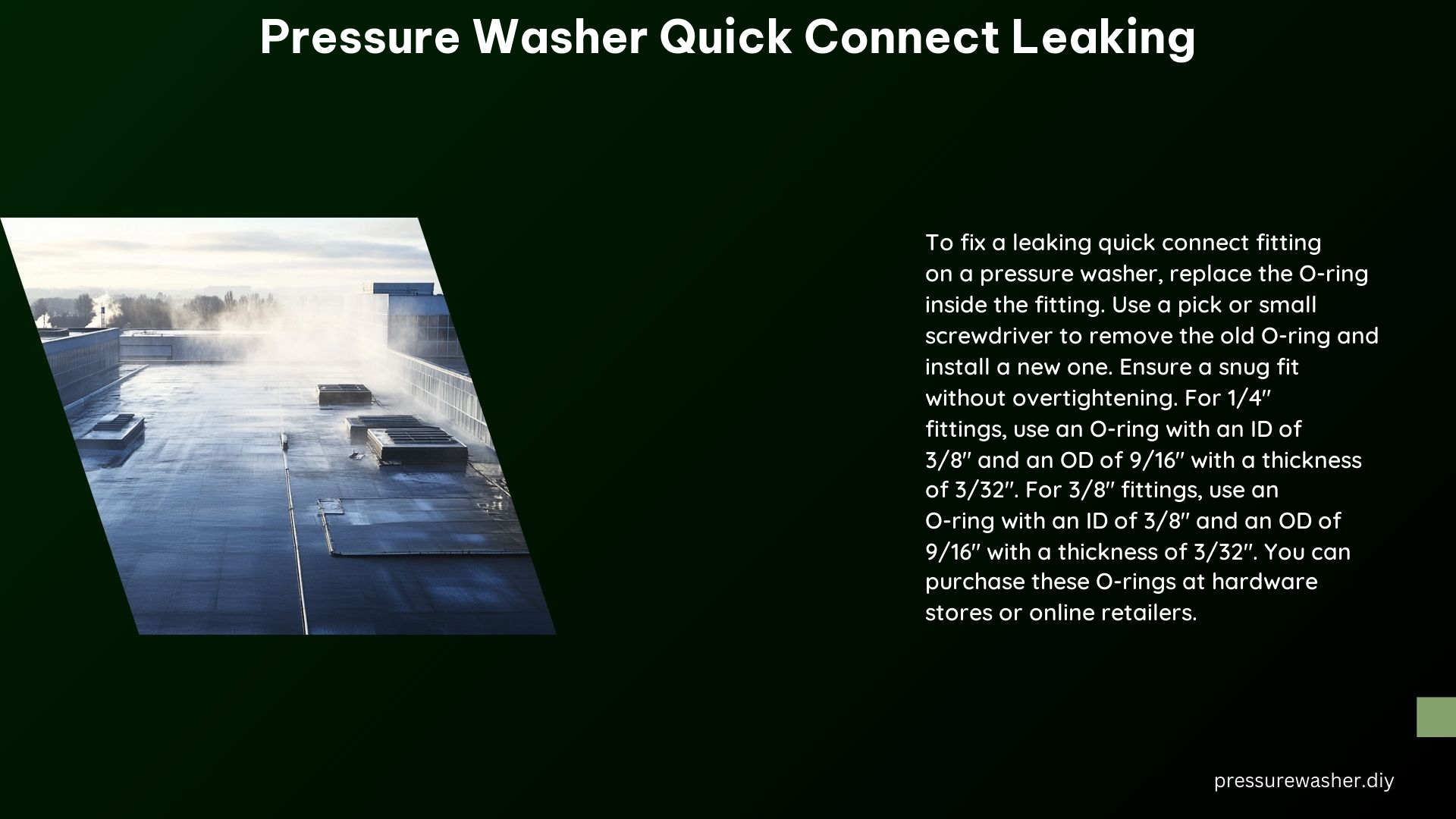Pressure washer quick connects are prone to leaking due to various reasons, such as worn-out O-rings, worn-out male fittings, and improper tightening. Understanding the causes and implementing the right solutions can help you effectively address this common issue and maintain the performance of your pressure washer.
Causes of Leaking Quick Connects
1. Worn-out O-Rings
The O-rings inside the quick connect fittings are responsible for creating a tight seal between the male and female components. Over time, these O-rings can wear out, leading to leaks. The rate of wear can depend on factors such as the frequency of use, water pressure, and the chemical composition of the cleaning solutions used.
Technical Specifications:
– Common O-ring sizes for pressure washer quick connects are 3/8″ and 1/4″ in diameter.
– O-rings can be made of various materials, including rubber and HNBR (Hydrogenated Nitrile Butadiene Rubber). HNBR O-rings offer better durability and temperature resistance compared to standard rubber.
– The inside diameter (ID) and outside diameter (OD) of the O-rings are crucial for a proper fit. Ensure you replace the O-rings with the correct size and material for your specific quick connect fittings.
2. Worn-out Male Fittings
In addition to the O-rings, the male fittings themselves can also wear out over time, especially if they are made of stainless steel. As the male fittings become worn, the surface can become rough or uneven, preventing a tight seal and leading to leaks.
Technical Specifications:
– Stainless steel male fittings are commonly used in pressure washer quick connect systems due to their durability and corrosion resistance.
– Over time, the constant exposure to high-pressure water and various cleaning chemicals can cause the surface of the male fittings to degrade, leading to leaks.
– Inspect the male fittings for any signs of wear, such as pitting, grooves, or a rough surface. Replace the male fittings if necessary to ensure a proper seal.
3. Improper Tightening
Incorrect tightening of the quick connect fittings can also contribute to leaks. Over-tightening can damage the components, while under-tightening can prevent a secure connection, allowing water to escape.
Technical Specifications:
– The recommended tightening method for quick connect fittings is to hand-tighten them until they are snug, without the use of a wrench or pliers.
– Applying excessive force with a tool can deform the fittings and compromise the seal, leading to leaks.
– Ensure the quick connect is tightened firmly but not over-tightened to maintain a proper seal and prevent damage to the components.
Solutions

1. Replace O-Rings
If the quick connect is leaking due to worn-out O-rings, the solution is to replace them with new ones. Use an O-ring picker or a small flat-head screwdriver to carefully remove the old O-ring, taking care not to damage the fitting. Insert the new O-ring, ensuring it is properly seated and not twisted.
Technical Specifications:
– Measure the existing O-ring to determine the correct replacement size. Common sizes are 3/8″ and 1/4″ in diameter.
– Consider upgrading to HNBR O-rings, which offer better durability and temperature resistance compared to standard rubber.
– Apply a small amount of silicone-based lubricant to the new O-ring before installation to ease the insertion and ensure a smooth operation.
2. Inspect and Replace Male Fittings
If the male fittings are worn out, they will need to be replaced to restore a proper seal. Carefully inspect the male fittings for any signs of wear, such as pitting, grooves, or a rough surface.
Technical Specifications:
– Stainless steel male fittings are commonly used in pressure washer quick connect systems due to their durability and corrosion resistance.
– Measure the diameter of the existing male fittings to ensure you purchase the correct replacement parts.
– When installing the new male fittings, ensure they are tightened securely but not over-tightened to prevent damage.
3. Adjust Tightening
If the quick connect is leaking due to improper tightening, the solution is to adjust the tightening to achieve a snug fit without over-tightening.
Technical Specifications:
– The recommended tightening method for quick connect fittings is to hand-tighten them until they are snug, without the use of a wrench or pliers.
– Avoid using excessive force, as this can deform the fittings and compromise the seal, leading to leaks.
– Ensure the quick connect is tightened firmly but not over-tightened to maintain a proper seal and prevent damage to the components.
Additional Tips
Use Plumber’s Tape
Applying plumber’s tape (also known as Teflon tape) to the threads of the quick connect fittings can help create a tighter seal and reduce the risk of leaks.
Regular Maintenance
Regularly inspecting and maintaining the quick connect fittings can help prevent leaks and extend their lifespan. This includes checking for worn-out O-rings and male fittings, as well as ensuring proper tightening.
References
- https://www.youtube.com/watch?v=7_HIKhI34Gw
- https://terrylove.com/forums/index.php?threads%2Fadvice-please-to-stop-leak-on-my-pressure-washer-at-the-hose-connection.94603%2F
- https://www.youtube.com/watch?v=kFcX_rVxr9Y
- https://www.youtube.com/watch?v=anSgfjc0yiE
- https://www.reddit.com/r/pressurewashing/comments/v5o7h6/my_quick_connect_fitting_is_leaking_whenever_i/
